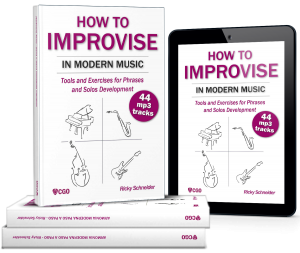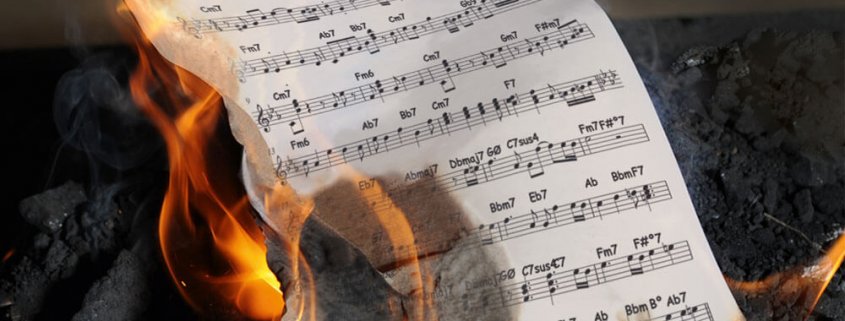Study improvisation
The idea of “Study improvisation” appears to be a contradiction in itself.
If you are reading this book you are surely looking for something new in your own way of improvising.
Beyond the level in which we may find ourselves, there is a moment when we have the feeling of playing always the same thing, or that our phrasing does not transmit what we want to say.
We perceive a difference between what we feel or listen to and what we might express.
We know one or several scales and we play them from top to bottom and what at first sounded attractive and creative has tired us. Every musician goes through such moments and this is when we take up our study again with new approaches and new practices.
In this book we shall see a great number of tools for developing both phrasing and solos, on many occasions using resources which we already know but from a different point of view, analyzing in detail how to play with them and how to reach our own new style which will provide an identity to our solos.
Improvising is a way to self-knowledge, a search which will be with us for the rest of our lives and provide a mirror to our personal growth. The thin line separating what we may change or improve upon from that which we will have to learn to live with is what shall define our style as musicians, understanding that when we play we play with what we are and we are that which we allow ourselves to be.
When improvising, our fear to show ourselves, our demands and our tolerances, the ability to communicate ( to listen and to intervene), patience and constancy, our ego, competing with or allowing that of others, our place in the group, etc., manifest themselves.
Working with harmonic concepts, scales and chords, makes us deal with an even greater challenge consisting of finding freedom while living under rules.
The various suggestions which we will find in this book and regular work with them are not a formula for improvising, but a sum of the resources from which we may make a choice, discarding those with which we may feel uncomfortable for different motives.
Clearly, to experience that feeling we must first experiment with those resources.To recognize ourselves in what and how we play will open up new ways for reaching our own style.
Study improvisation: the five centers
In the study of music, in general, and in improvising, in particular, we may distinguish five centers participating on learning either successively or simultaneously, and which are not always developed to the same degree or, what is worse, one of those centers is used for certain activities which correspond to another.
These centers are: rational, motor, sensorial, emotional and intuitive. This idea is based on the book: “Psychology of man’s possible evolution” by P. D. Oupensky.
Rational: this is all that which has to do with understanding through reason, such as harmony, solfeggio, musical styles, etc.
Motor: this is the learning of body movements interacting with our instrument, mainly the technique and the relationship we establish through these centers) with the other centers.
Minimal distances which our fingers must follow to go from one note to another are not common in our daily lives and the precision required comes after a long period of training leading to mastery in interpreting, speed and, therefore, relaxation. This will lead to the kind of sound we are looking to obtain.
Sensorial: in our case, this is the development of our hearing. Identifying notes, intervals, scales, chords, etc. Although some persons have an innate quality or one learned subconsciously during the first years of our lives, generally, and due to the environment where they have been raised, others will need practice to educate their hearing. This is something which is possible notwithstanding certain beliefs against this concept.
Emotional: To enter in contact with our emotions when improvising, composing or interpreting will allow a close relationship with our hearers and with ourselves, transmitting a close message on “that” which we have to say.
Without going into psychological aspects, there are several techniques for the development of creativity leading to an easier expression of our emotions without barriers or prejudices.
Love, rage, sadness, euphoria, any momentary emotional state may flow in the same manner without ethical or moral categorizations.
Intuitive: according to one dictionary definition, intuition is: “The faculty for instantaneously understanding matters, without recourse to reasoning”. According to Wikipedia, intuition (from the Latin intueri, “to look inside” or “to contemplate”) is a concept from the Theory of nowledge, also applied in epistemology for describing direct and immediate knowledge, without intervention of deduction or of reasoning, and being considered as evident.
We might then say that trying to define intuition would be contradictory.
However, there are neuroscientific reasons for differentiating intuitive from systematic reasoning, both in the pathways of the brain subserving this faculty and in the way those pathways allow for a faster transfer of information between the brain nuclei involved. (E. Castro-Sierra, Personal communication).
In any case, the main thing is that when we talk of intuition we know what we are talking about.
It will be important to preserve this ability as we advance in the study of music, since it will guarantee freshness of improvisation beyond any influence we may have previously had.
These five centers are connected among themselves and information will flow easily from one to another if we do not voluntarily interfere with the process preventing communication. For example, when we learn to drive a car, the first steps will be purely theoretical (rational): clutch, low gear, accelerator, etc.
With practice, this mechanical response will transfer to our motor center, i.e., a part of our brain will start memorizing these movements, and we will go through the steps for driving a car without thinking about them, which makes everything more fluid and efficient.
If, for any motive, we should hang on to carrying out this process rationally, driving would become slow and unsteady and we would surely commit many mistakes due to the insecurity stemming from having two different types of memory (factual and automatic) confront each other.
In other words, the need we originally had of a reason to begin learning will turn into a hamper if we do not allow what we have learned to originate from its corresponding center and location of the same in the brain.
This mechanism becomes much more complex in music, since several conditioning elements intervene. On many occasions, several centers act simultaneously, thus achieving actions which come from everywhere within ourselves. Surely, you must have developed one of those centers more than the others, as frequently happens.
When we approach music for the first time, we take support from whatever comes more easily to us and, therefore, develop it more.
If we have an auditory ability, we will imitate those musicians whose phrases we like imitating, developing the ear to a greater extent, perhaps without knowing what are we playing, or whether we are using the right technique, which will later on load us with limitations in those particular areas.
 This post is part of my book
This post is part of my book
How to Improvise im Modern Music
available in




Leave a Reply
Want to join the discussion?Feel free to contribute!